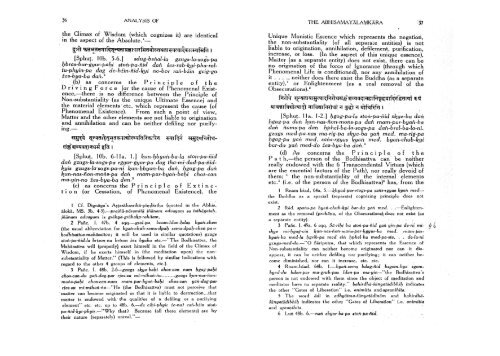ABHISAMAYALAMKARA
ABHISAMAYALAMKARA
ABHISAMAYALAMKARA
You also want an ePaper? Increase the reach of your titles
YUMPU automatically turns print PDFs into web optimized ePapers that Google loves.
ANALYSIS OF<br />
the Climax of Wisdom (which cognizes it) are identical<br />
in the aspect of the Absolute. 1 —<br />
[Sphut. 10b. 5-6.] $dug~bshal-la gzugs~la~sogs~pa<br />
hbras-bur-gyur-pahi stoh-pa-hid dan ses-rab~kyi~pha-rol~<br />
tu-phyin-pa dag de-bzin-hid-J^yi no-bor ran~bzin gcig-ga<br />
zes-bya~ba dan. 2<br />
(b) as concerns the Principle of the<br />
D r i v i n g F o r c e (or the cause of Phenomenal Existence,—-there<br />
is no difference between the Principle of<br />
Non-substantiality (as the unique Ultimate Essence) and<br />
the material elements etc. which represent the cause (of<br />
Phenomenal Existence). From such a point of view.<br />
Matter and the other elements are not liable to origination<br />
and annihilation and can be neither defiling nor purifying,<br />
" .;' ' ' ' .. •<br />
[Sphut. 10b, 6-1 la. 1.] kun-hbyuh-baAa $toh~pa~nid<br />
dan gzugs-la-sogs-pa rgyttr-gyur-pa dag tha-mt-dad-pa-nidhyis<br />
gzugs-lasogs-pa-ni kun-hbyun-ba dan, hgog-pa dan<br />
j^uri-fias-non-mans-pa dan rnatn^par-byah-bahi chos-can<br />
ma-yin-no zes-bya-ba dan. 3<br />
(c) as concerns the Principle of Extinction<br />
(or Cessation, of Phenomenal Existence), the<br />
1 Cf. Dignaga's Astasahasrika-pindartha (quoted in the Abhis.<br />
aloka, MS. 3b. 4-5).—prajna-paramita jnanam advayam sa tathagatah.<br />
jnanam advayam is grahyagrahaka-rahitam.<br />
2 Pane. I. 47b. 4 sqq.—gsol-pa. bcom-ldan-hdas byah-chen<br />
(the usual abbreviation for byan-chub-sems-dpah sems-dpah-chen po =<br />
bodhisattva-mahasattva; it will be used in similar quotations) • gzugsston-pa-nid-la<br />
brtson-na brtson zes byaho etc.—"The Bodhisattva, the<br />
Mahasattva will (properly) exert himself in the field of the Climax of<br />
Wisdom, if he exerts himself in (the meditation upon) the nonsubstantiality<br />
of Matter," (This is followed by similar indications with<br />
regard to the other 4 groups of elements, etc.).<br />
3 Pane. I. 48b. 2-6—gzugs skye-bahi chos-can nam hgag-pahi<br />
cho$-can-du yan-dag~par rjes-su mi-mihon-no.........gzugs kun-nas-nonmons-pahi<br />
chos-can-nam rnam-par-byan-bahi chos-cm yan~dag~par<br />
" rjessu tni-mthon-na—"He (the Bodhisattva) must not perceive that<br />
matter can become originated or that it is liable to destruction...that<br />
matter is endowed with the qualities of a defiling or a purifying<br />
element" etc. etc. up to 48b. 6.—de cihi-phyir £>e-na rah-bzin sioh~<br />
pa-nid-\yi-phyir.—"Why that Because (all these elements) are by<br />
their nature (separately) unreal."—<br />
THE <strong>ABHISAMAYALAMKARA</strong><br />
Unique Monistic Essence which represents the negation,<br />
the non-substantiality (of all separate entities) is not<br />
liable to origination, annihilation, defilement, purification,<br />
increase, or loss. (In the aspect of this unique essence),<br />
Matter (as a separate entity) does not exist, there can be<br />
no origination of the force of Ignorance (through which<br />
Phenomenal Life is conditioned), nor any annihilation of<br />
it . . . ., neither does there exist the Buddha (as a separate<br />
entity), 1 or Enlightenment (as a real removal of the<br />
Obsecurations). 2 ,<br />
[Sphut. lla. 1-2.] hgog-pa4a ston-pa-md sky'e-ba daft<br />
hgag-pa dan kun-nas-non-mohs-pa dan rnam-par-byan-ba<br />
dan nams-pa dan hphel~ba~la~sogs~pa dan-brai-ba~la~ni.<br />
gzugs med-pa~nas ma-rig-pa s%e-fca< yah med. ma-rig-pa<br />
hgag~pa yah med. sahs-rgyas kjJ a n med. byah-chub-kyi<br />
bar-du yah med-do zes-bya-ba dan. 3<br />
(d) As concerns the Principle of the<br />
Pat h,—the person of the Bodhisattva can be neither<br />
really endowed with the 6 Transcendental Virtues (which<br />
are the essential factors of the Path), nor really devoid of<br />
them; 4 the non-substantiality of the internal elements<br />
etc. 5 (i.e. of the person of the Bodhisattva) 6 has, from the<br />
1 . Rnam-blad, 64a. 5.-—Jihyad-par-rtogs-pa sans~rgya& klf a^- med—<br />
the Buddha as a special (separate) cognizing principle* does not<br />
exist.<br />
2 Ibid, spans pa byan~chub-kyi bar-du yan med. . .—Enlightenment<br />
as th& removal (prahana, of the Obscurations^ does not exist (as<br />
a separate entity). ' • - , • .. . . . -. ...... • • --< •-<br />
3 Pane. I. 49a. 6 sqq. £d~rihi bu ston-pa-nid gan yin-pa de-ni mi' /*<br />
skye mi-hgag-cin ^un-nas-non-mons-par-j[ig|/tir-oa med. mam-par-*<br />
byan-ba med-la hgrib-pa med ein hphel-ba med-paste. . . - de~la~ni<br />
gzugs-med-do.—-**O &ariputra, that which represents the Essence of<br />
Non-substantiality can neither become originated nor can it disappear,<br />
it can be neither defiling nor purifying; it can neither become<br />
diminished, nor can it increase, etc. etc.<br />
4 Rnam-bsad. 64b. 1.—byan-sems bdag-nid bsgom-bya sgombyed-du<br />
bden-par ma~grub~pas Idan-pa ma-yin—"the Bodhisattva's<br />
person is not endowed with them since the object of meditation and<br />
meditator have no separate reality." bahirdha-sunyaiadibhih indicates<br />
the other **Gates of Liberation" i.e. animitta and apranihita,<br />
5 The word adi in adhyatma-sunyatadinam and bahirdhasunyatadibhih<br />
indicates the other "Gates of Liberation"* i.e. animitta<br />
and apranihita.<br />
6 Luii 48b. 6.—nan sbyor-ba-po stoh-pa-nid.












![Long Discourses of the Buddha [Digha Nikaya]](https://img.yumpu.com/32792419/1/164x260/long-discourses-of-the-buddha-digha-nikaya.jpg?quality=85)


